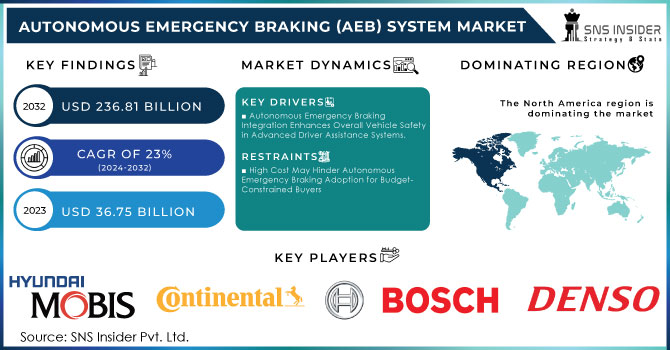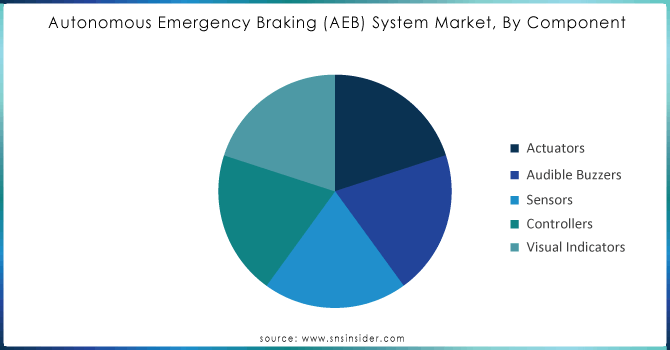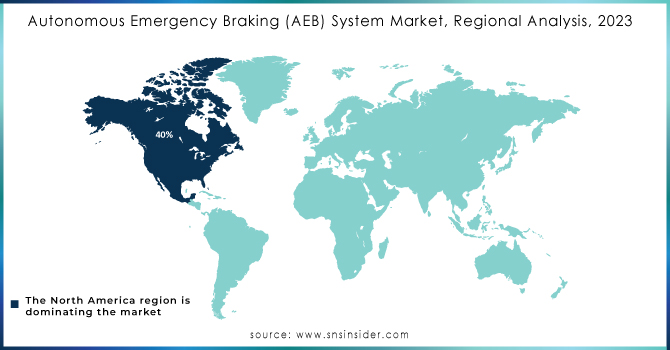Autonomous Emergency Braking System Market Size & Overview:

Get More Information on Autonomous Emergency Braking (AEB) System Market - Request Sample Report
The Autonomous Emergency Braking (AEB) System Market Size was valued at USD 36.75 billion in 2023 and is expected to reach USD 236.81 billion by 2032 and grow at a CAGR of 23% over the forecast period 2024-2032.
Autonomous emergency braking (AEB) systems are getting to be well known in the automotive industry as a pivotal security feature. These systems utilize a network of onboard sensors, cameras, and radars to continually scan the street ahead, recognizing potential collisions with vehicles, people on footpath, and other obstacles. When the system identifies an imminent crash and the driver fails to react in time, AEB can automatically engage the brakes with full force, potentially preventing the accident altogether or significantly reducing its impact. This technology is experiencing a surge in demand due to the alarming rise in road accidents globally. The widespread adoption of advanced braking systems in general is paving the way for a smoother transition towards AEB. Beyond just detecting stationary or moving vehicles, the latest AEB systems are equipped to identify pedestrians and cyclists as well, offering a more comprehensive layer of protection on the road. This enhanced responsiveness to various road users significantly bolsters overall traffic safety.
MARKET DYNAMICS:
KEY DRIVERS:
-
Autonomous Emergency Braking Integration Enhances Overall Vehicle Safety in Advanced Driver Assistance Systems.
Advanced Driver Assistance Systems are a suite of technologies that enhance safety on the road. This includes features like collision avoidance, adaptive cruise control, and lane departure warning. A key component of many ADAS systems is Autonomous Emergency Braking. This technology uses sensors to detect potential crashes and automatically applies the brakes if the driver doesn't react in time. By working together, AEB and other ADAS features create a layered approach to safety, helping drivers avoid accidents or minimize their severity.
-
Insurance Incentives Drive Adoption of Modern Safety Features Like Autonomous Emergency Braking Systems
RESTRAINTS:
-
High Cost May Hinder Autonomous Emergency Braking Adoption for Budget-Constrained Buyers
While autonomous emergency braking systems offer significant safety benefits, their installation can be expensive. This high cost might discourage budget-conscious consumers and organizations, especially in regions where affordability is a primary concern. This price barrier could potentially hinder the widespread adoption of AEB technology, limiting its reach and overall impact on road safety.
OPPORTUNITIES:
-
The integration of AEB with other Advanced Driver-Assistance Systems will create a more comprehensive safety package for vehicles.
-
Growing public awareness about road safety will increase demand for autonomous emergency braking systems.
CHALLENGES:
-
High upfront cost of AEB systems may discourage budget-conscious buyers.
-
Technical limitations exist, as AEB systems can struggle in certain weather conditions or with complex obstacles.
IMPACT OF RUSSIA-UKRAINE WAR
The Russia-Ukraine war is disrupting the Autonomous Emergency Braking (AEB) system market's growth with 5-10% of share as a combination of dampened consumer spending due to global inflation and potential recession especially impacting sales of new cars with high AEB adoption, supply chain disruptions causing up to 15% manufacturing hurdles for AEB systems due to chip shortages stemming from factory closures and logistical jams, and geopolitical tensions making it more difficult to source raw materials and finished AEB components from certain regions due to sanctions and a strained global political climate, will all negatively impact overall production. However, there are potential long-term upsides such as increased focus on road safety measures that could lead to stricter government mandates for AEB systems, and growing public awareness of the technology's life-saving capabilities that could incentivize car manufacturers to prioritize AEB integration despite current challenges.
IMPACT OF ECONOMIC SLOWDOWN
An economic slowdown can impact the Autonomous Emergency Braking (AEB) system market in several ways. The consumer spending is likely to decline by around 5-7%, especially for optional purchases like new vehicles. This directly affects AEB adoption, as newer car models boasting advanced safety features are often the primary segment for AEB integration. The slowdown can worsen existing supply chain issues. With production lines potentially slowing down across industries, AEB system manufacturing could face delays of up to 10% due to a shortage of crucial components. This could be particularly true for semiconductors, often manufactured where factory shutdowns and logistical jams create roadblocks. The overall impact translates to a potential stalling of AEB market growth in the short term. Economic downturns can sometimes lead governments to prioritize public safety measures.
KEY MARKET SEGMENTS:
By Component:
- Actuators
- Audible Buzzers
- Sensors
- Controllers
- Visual Indicators
The Sensors is the dominating sub-segment in the Autonomous Emergency Braking (AEB) System Market by component holding around 40-45% of market share. Sensors are the heart of the AEB system, gathering crucial data about the surrounding environment (vehicles, pedestrians, etc.) They play a critical role in detecting potential collisions and triggering appropriate braking responses.

Get Customized Report as per your Business Requirement - Request For Customized Report
By Operating Speed:
- High Speed-Inter Urban AEB Systems
- Pedestrian-VRU (Vulnerable Road Users) AEB Systems
- Low Speed-City AEB Systems
Low Speed-City AEB Systems is the dominating sub-segment in the Autonomous Emergency Braking (AEB) System Market by operating speed holding around 55-60% of market share. Low-speed AEB systems are particularly important in urban environments with frequent stop-and-go traffic and a higher risk of pedestrian collisions. They offer a readily deployable safety feature for a wider range of vehicles compared to high-speed systems.
By Application:
- Forward Emergency Braking
- Multi-directional Braking
- Reverse Emergency Braking
Forward Emergency Braking is the dominating sub-segment in the Autonomous Emergency Braking (AEB) System Market by application holding around 70% of market share. Forward AEB is the most basic and widely adopted application, focusing on preventing frontal collisions with vehicles or stationary objects. It offers a significant safety benefit for drivers and is often a prerequisite for achieving higher safety ratings.
REGIONAL ANALYSES
North America is the dominating region in Autonomous Emergency Braking System Market holding market share of 35-40%. North American consumers prioritize safety features, leading to a strong demand for AEB in new vehicles. Government regulations and initiatives promoting advanced driver-assistance systems further propel market growth in this region. Europe is the second highest region in this market holding market share of 30-35%. Europe has a strong focus on road safety and stringent regulations mandating AEB systems in many new car models. This, coupled with a technologically advanced automotive industry, drives market growth in Europe. The Asia Pacific is experiencing the fastest growth in this market holding around market share of 20-25%. The Asia Pacific region, particularly China and India, is experiencing rapid growth in vehicle production and rising disposable income. This, combined with increasing awareness of safety features and government initiatives promoting ADAS technologies, is fueling a significant market expansion for AEB systems in this region.

KEY PLAYERS
The major key players are Robert Bosch GmbH (Germany), ZF Friedrichshafen AG (Germany), Continental AG (Germany), Denso Corporation (Japan), Valeo S.A. (France), Hyundai Mobis Co., Ltd. (South Korea), Aisin Seiki Co., Ltd. (Japan), Paccar Inc. (DAF) (US), Autoliv, Inc. (Sweden), Delphi Automotive PLC (UK), Infineon Technologies AG (Germany), Knorr-Bremse AG (Germany), Mando Corporation (South Korea), Analog Devices, Inc. (US), Wabco Holdings, Inc. (US) and other key players.
RECENT DEVELOPMENTS:
-
In Jan. 2024: Valeo and Teledyne FLIR are teaming up to create the first ASIL B thermal imaging system for nighttime ADAS. This tech will boost road safety by improving night vision in features like automatic emergency braking for all types of vehicles.
-
In Nov. 2023: ZF has introduced a revolutionary braking system. Ditching hydraulics and fluid, this "dry brake" system uses electric motors at each wheel to deliver braking force. This innovation promises improved braking distance, energy recovery, and lower maintenance costs.
| Report Attributes | Details |
| Market Size in 2023 | US$ 36.75 Bn |
| Market Size by 2032 | US$ 236.81 Bn |
| CAGR | CAGR of 23% From 2024 to 2032 |
| Base Year | 2023 |
| Forecast Period | 2024-2032 |
| Historical Data | 2020-2022 |
| Report Scope & Coverage | Market Size, Segments Analysis, Competitive Landscape, Regional Analysis, DROC & SWOT Analysis, Forecast Outlook |
| Key Segments | • By Component (Actuators, Audible Buzzers, Sensors, Controllers, Visual Indicators) • By Operating Speed (High Speed-Inter Urban AEB Systems, Pedestrian-VRU (Vulnerable Road Users), AEB Systems, Low Speed-City AEB Systems) • By Application (Forward Emergency Braking, Multi-directional Braking, Reverse Emergency Braking) |
| Regional Analysis/Coverage | North America (US, Canada, Mexico), Europe (Eastern Europe [Poland, Romania, Hungary, Turkey, Rest of Eastern Europe] Western Europe] Germany, France, UK, Italy, Spain, Netherlands, Switzerland, Austria, Rest of Western Europe]), Asia Pacific (China, India, Japan, South Korea, Vietnam, Singapore, Australia, Rest of Asia Pacific), Middle East & Africa (Middle East [UAE, Egypt, Saudi Arabia, Qatar, Rest of Middle East], Africa [Nigeria, South Africa, Rest of Africa], Latin America (Brazil, Argentina, Colombia Rest of Latin America |
| Company Profiles | Robert Bosch GmbH, ZF Friedrichshafen AG, Continental AG, Denso Corporation, Valeo S.A., Hyundai Mobis Co., Ltd., Aisin Seiki Co., Ltd., Paccar Inc. (DAF), Autoliv, Inc, Delphi Automotive PLC, Infineon Technologies AG, Knorr-Bremse AG, Mando Corporation, Analog Devices, Inc., Wabco Holdings, Inc. |
| Key Drivers | • Increased automobile sales around the world help propel the market. • The market is being propelled by the increasing deployment of sophisticated braking systems. |
| Challenges | • The AEB system is unable to identify the dangers and problems that are there. • One of the major issues is sensing, which includes categorizing and properly anticipating the movement of VRUs. |

